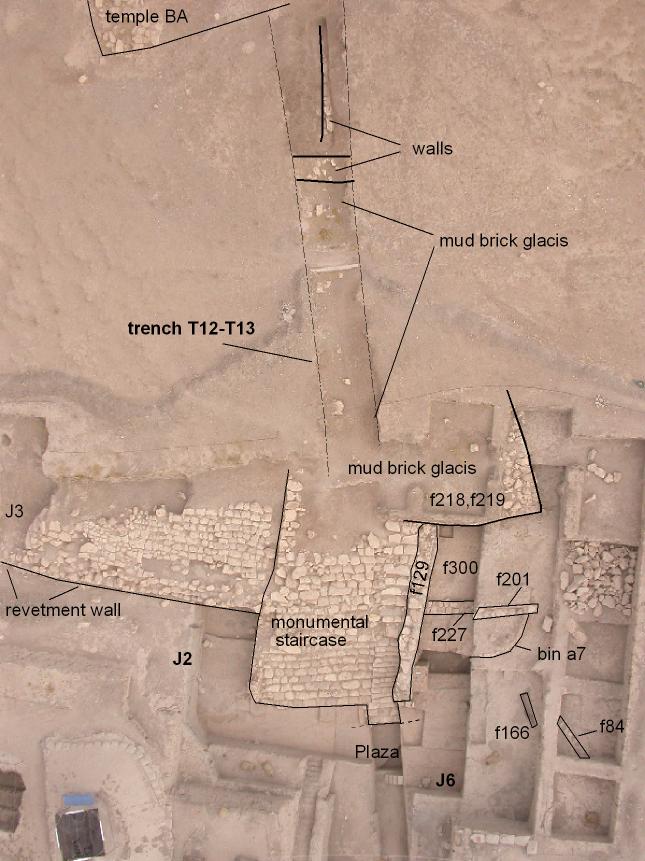Back to top: Construction
Walls
J4 contains 5 constructs that were identified as walls. in most cases, the walls only consists of one row of stones or mudbricks.
Building activities took place on the Western part of the temple mound in the Imperial Akkaddian period, where the stone wall f10 (same as J6f219 which is a part of J6f218), was probably constructed, constituting an extention of the revetment wall. In the subsequent period of the Early Mittani, laying directly over the Akkadian material, a Buildup of the area took place with some reorganization around the monumental staircase, but no constructions in J4.
However, in the Middle Mittani period, major rebuilding took place in different areas of the Tell, including J4. All the walls (except f10) were built during this period (f159, f84, f171, f161 and f162), none of which give a clear inication of their function. The fact that in most cases we have only one row of stone without an evidence indicating that there once was more and it got damaged or repurposed at a later stage, leads to the assumption that these walls were only dividers and not parts of a larger functional construction.

Back to top: Construction
Floors and pavements
The only surface that was identified as a floor surface is f38, floor type d. This floor surface, in between two natural accumulation layers, belongs to a Middle Assyrian/ modern period.
As part of the reorganization of the area in the Early Mittani period and the rebuilding that took place in the Middle Mittani period, two surfaces were identified as pavements. f154, a sherd pavement of the Early Mittani, partially covered by one of the bin (f39) componenets, wall f162. The second pavement is the the floor of the bin f93. This attests to the activitites that took place in the area east of the monumental staircase and revetment wall, even in excavation units that demonstrated so little use.
Back to top: Construction
Pits
J4 contained two large pits (f85 and f136) located in proximity to each other, and date to the same time period and consecutive strata of minor and scattered use of the area.
During the Middle Mittani, the monumental staircase was still visible and in use, and despite the fact that the area to the east was a service area for the monumental complex, it would still be kept in a decent condition. The presence of such pits is peculiar as we do not their function. The ones in J4 were definitly not trash pits.
a1 for example contained nothing but animal bones, leading us to think that it might have been dug especially for this purpose, wheather it is related to a special ritual or not, remains unclear.
Even the bin installation, f93, presumed for storage purposes, was empty and gives no sign of the nature of the stored items.
The same scenario occurs in J6 with the 2 pits located directly east of wall^6, still visible by then, filled with charcoal, ashy earth, animal bones, objects and pottery.
It is interesting to note that the pit cut f136 cuts glacisf121, the same way the pits in J6 cut the glacis.
Back to top: Construction
Bin
The most interesting and complex structure in J4 is the bin installation f93, due to its presumed function and its proximity to an area considered sacred.
Bin f93 and its components are assigned the aggregate number a3. it consists of a a pebbble floor f143, enclosed in a semicircular brick wall (2 lines of medium small bricks resting on a row of small-regular stones, with stone foundations, and other 2 brick walls to the north (f161, f162, where f162 is the less preserved portion of the mud-brick wall f161).
It is safe to say that by the time the bin was constructed, wall f10, the closest construction to it, was no longer visible. The same applies for J2f130J2f130. However, memory stones still conserved the sanctity of the space, which makes the presences of a storage entity, such as the bin, unusual. even if we take into consideration the fact that this was presumably a service area related to the temple, more evidence is required to support such hypothesis.

Back to top: Construction
Glacis
5 features were identified as glacis layers in J4. However, they constitute two glacis. Glacis f127 is the same as f77 extending in two adjacent loci k72 and k82 and pertaining to the Mittani period, and glacis f150, equal to f158 and f160, dating to Akkaddian period period.
After some delierations with pC about the identification of f121 as brickfall, pC pointed out that in the light of the excavations of J6, the lower portion of f121 is part of ^glacis3 of J6 and not a brickfall, while the top part belongs to the Early Mittani period.
Back to top: Construction